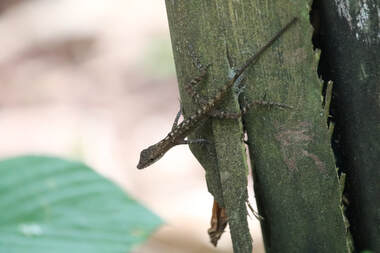Our new paper on the ecological dynamics of coral snake mimicry in the montane tropics has just been published! This work was the M.S. thesis of first author Lauren Wilson. We studied predator-based selection on coral snake mimicry in areas of edge sympatry and allopatry to coral snakes in the montane rainforest in Honduras. We found that counter to research in the lowland tropics, we did not consistently detect a protective function of mimetic coloration. Click the link to read the paper.
|
We have just published a new paper on the systematics of Mexican rattlensnakes! In this perspective piece, we consider recent revisions based upon mtDNA in the light of what is known about mitochondrial genome sequence evolution, and recommend restraint in the absence of robust data. Click the link to read the paper.
Our new paper describing the genome of the eastern fence lizard was just published! Click the link to read the paper.
Our new paper on the evolutionary origins of viviparity was just published in the Journal of Experimental Zoology B! In this perspective piece, collaborator Matt Watson and I note that many of the evolutionary origins of viviparity occur at high elevations, which are cold and have lower oxygen availability. We advocate for research to study the impact of hypoxia on development of embryos and juveniles under hypoxia in both live-bearing and egg-laying species. The lizard above is Yarrow's spiny lizard (Sceloporus jarrovii), which is viviparous lizard that is found at high elevations. Check out the link to read the paper!
Our new paper on how habitat structure can impact vulnerability to climate change in slender anoles and brown anoles was just published in Biotropica! We found that habitat variability can permit behavioral compensation for a warming climate. Hence, the forest-dwelling slender anoles are more likely to be negatively impacted by a warming climate than brown anoles, which are found in habitats with greater thermal heterogeneity. Check out the link to read the paper!
We are excited to have two new collaborators and PhD students in the lab! Kelly joins us from SUNY-Binghamton, where she studied coloration of water anoles. Leah Bakewell joins the lab from Sul-Ross State University, where she earned an MS studying the immune system of red-spotted toads. Welcome to south Florida!
Our new paper on how resting metabolic rate differs between sexes differently on different islands was just published in Physiological and Biochemical Zoology! In this manuscript, we demonstrate that males from a population of brown anoles with greater male-biased sexual size dimorphism have lower metabolic rates than those from a population with less male-biased sexual size dimorphism. We then discuss the mechanisms that might underly this interesting pattern. This paper is the culmination of work that first author John David Curlis and I began in Bob Cox's lab at the University of Virginia. Check out the link to read the paper!
Our new paper on antipredator displays in ringneck snakes was just published in the journal Ethology! We found that tactile, rather than visual stimuli, induce antipredator displays in ringneck snakes. These snakes have a bright orange venter, and tactile stimuli cause them to writhe and show their venter and bottom of the tail. This work came out of a class project for the Field Herpetology class at Mountain Lake Biological Station. Check out the link to read the paper!
Our new paper on the spatial and temporal dynamics of color polymorphism in the southern cricket frog was just published in the Journal of Natural History! This work was the culmination of a couple of undergraduate research projects and a collaboration with Jeff Streicher at the Natural History Museum. We found more spatial than temporal variation in color polymorphism, and also documented variation in multiple color traits. We suggest that cricket frogs may have exuberant color polymorphism, where the variation in multiple color traits creates up to a dozen or more color morphs within a population. Check out the link to read the paper!
Collaborator Mike Logan and myself have just published a new paper on integrative biology and inferring adaptation. In this perspective paper, we argue that deeply integrative studies of only a few species can serve as a useful complement to broad comparative studies with many species. Check out the link to read the paper!
|








